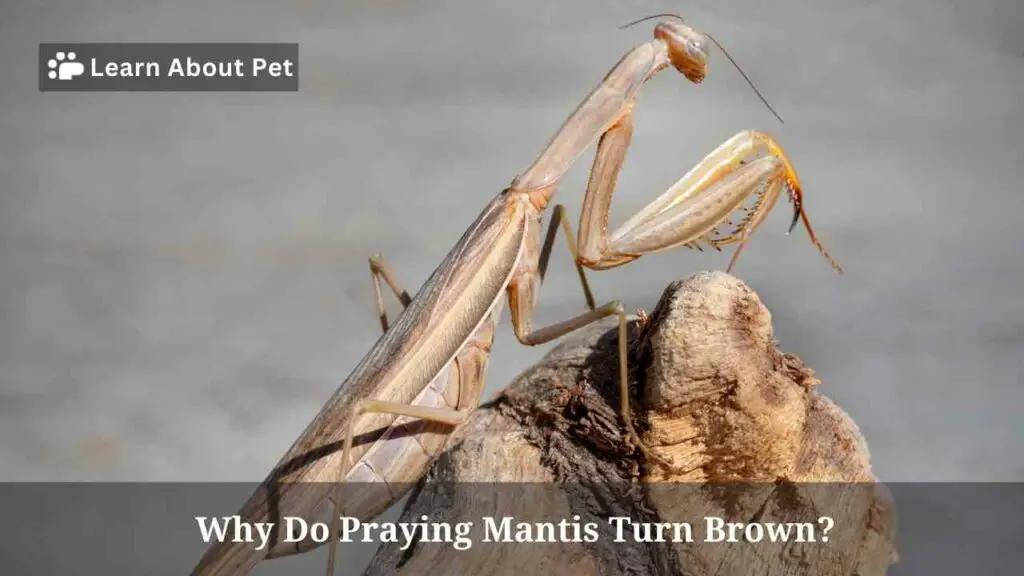Praying mantis is a unique insect with a natural green color when living in vegetation with a frightening appearance and capable movements to catch prey.
The body color of praying mantis will make it easier for them to blend with their environment and be an advantage for their life in the wild. Some owners of pet mantis have noticed that their pets can change color from green to brown.
Why do praying mantis turn brown? The praying mantis turning brown to adapt to where it lives. The process of praying mantis changing their body color cannot be instant, and must go through a molting process. Pet praying mantis can turn brown depending on light intensity, humidity, and temperature.
Mantis will adapt to their environment to make it easier for them to camouflage. The final possibility is that mantis changes color because of certain diseases.

Praying mantis cannot change their body color as drastically as chameleons. We need to learn about when praying mantis turn brown, whether brown mantis are harmful or not, and what we need to do if something happens to our pet.
Why Do Praying Mantis Turn Brown?
Yes, mantis can turn brown, which allows them to disappear into their habitats when they live in an environment with a dominant brown color. Praying mantis can only change color gradually, and it takes several days.
What Does It Mean When A Praying Mantis Is Brown?
Green mantis becomes brown mantis when they live on the ground or branches of trees with a brown color. These mantises will change their original body color from green to brown with molting process and usually hide among branches or fallen twigs.
Praying mantis will find prey effortlessly when they can blend into their environments. After the praying mantis returns to its original place with green vegetation, they will molt and return to green again.
What Is The Difference Between Brown And Green Praying Mantis?
Let’s check praying mantis brown vs green. Praying mantis brown belongs to the genus Mantodea and is a close relative of termites and cockroaches.
The brown mantis lives in branches and tree trunks. Brown mantis may or may not have wings. Brown praying mantis have wings that make it easier for them to transport and catch flying prey.
Green praying mantis live in green vegetation and have more slender bodies. Green mantis have wings as adults to make it easier for them to seek out a mate and catch prey.
Why Are Some Praying Mantis Brown?
Some praying mantis are brown because their life is on the ground. Praying mantis will find it easier to catch prey secretly when they can blend with their environment.
Praying mantis can change their color gradually to gain an advantage in their new environment.
Why Is A Praying Mantis Brown?
A praying mantis can be brown because their habitat is on the ground. But there are praying mantis with a natural green color and can slowly change to brown.
Praying mantis turning brown depends on several factors. Pet praying mantis can change color to brown depending on temperature, humidity and light intensity.
Why Is My Praying Mantis Brown?
Praying mantis is an insect with the nickname master of disguise. They can blend perfectly with the color of their habitat, making it difficult for us to spot them in the wild. Check whether your pet mantis lives in green vegetation or on the ground.
Why is my praying mantis brown and not green? Another cause for mantis becoming brown could be sickness or disease. Mantis will experience discoloration with small brown patches or dots on the wings or back of your mantis.
Why Are Praying Mantis Brown?
Brown mantises are common in tropical and subtropical regions. There are some green praying mantis that turn brown if they change habitat. Why do praying mantis turn brown? Praying mantis becomes brown to blend in with bark, dead leaves, twigs, or branches.
Changes on diet can change the color of praying mantis to brown. When praying mantis eat dirt, rubble, or prey obtained from a tree branches, they will develop a brownish hue on their body exterior.
Are Brown Praying Mantis Good Or Bad?
Brown or green praying mantis is a beneficial insect that preys on insect pests in the garden. Mantis play essential roles in maintaining ecosystem balance.
Although the praying mantis is a carnivore and an outstanding predator, it is harmless to humans.
What Is A Brown Praying Mantis With A Green Belly?
The Chinese mantis is a brown praying mantis with a green belly. The body of the Chinese mantis is long and slender, with a length of almost 11 cm and is the largest mantis species in North America.
Do Praying Mantis Turn Brown When They Die?
Praying mantis will not turn brown when it dies. Praying mantis can turn brown after molting and typically the final stage of mantis’ life cycle.
The mantis becomes brown not because it dies, but because of the molting process to adapt to the surrounding environment.
Is Brown Praying Mantis Dangerous?
Brown praying mantis is not dangerous. You must understand several possibilities that praying mantis can turn brown. The table below will make it easier to know why mantis becomes brown.
| Why is Praying mantis turning brown | Explanation |
| Molting | Mantis shed their outer skin and form a new exoskeleton. Most praying mantises after the molting process have a brown color. |
| Change in diet | Mantis’ bodies correspond to the type of food they eat. Ground praying mantis tend to survive on food with brown colors like rubble, dirt, and brown insects. |
| Change in environment | Mantis gradually change their color to brown and take several days or weeks. Mantis must be able to blend into their habitat and hide from their prey. |
| Sickness or infection | Mantis is not entirely turning brown, and only forms discoloration. Mantis will have small brown patches and dots on their back and wings due to sickness or disease. |
Final Verdict
The praying mantis turning brown due to molting, adapting to its habitat, or changing on their diet. Some praying mantis species that live on the ground have a brown color.
They can change the color from green to brown or vice versa when they want to blend with their environment.
Mantises experiencing sickness or disease may have small brown patches on their wings or back, but this does not change their body color completely.

Welcome to Learn About Pet. My name is Rajkumar Ravichandran and I love all pets, travel, and amazing food. I write about my passion and personal experience caring for multiple pets in this blog! ❤️
Post Disclaimer
DISCLAIMER: THIS BLOG OR WEBSITE, "Learn About Pet", DOES NOT PROVIDE YOU WITH MEDICAL ADVICE AND IS NOT A SUBSTITUTE FOR MEDICAL ADVICE. ALWAYS GET IN TOUCH WITH YOUR PERSONAL VETERINARIAN AND USE INFORMATION HERE AS GENERAL ADVICE.
The information, including but not limited to, text, graphics, images and other material contained on this website are for informational purposes only. No material on this site is intended to be a substitute for professional veterinary advice, food recommendation, diagnosis, or treatment. Always seek the advice of your veterinarian or other qualified health care provider with any questions you may have regarding a medical condition or for pet food related questions.







